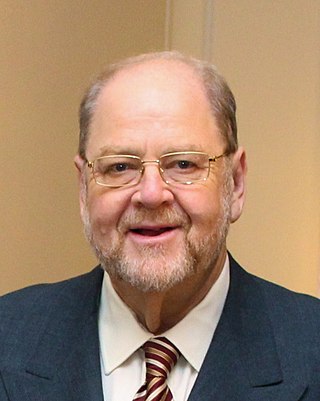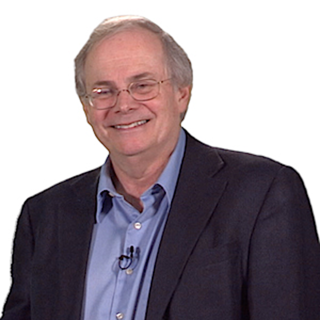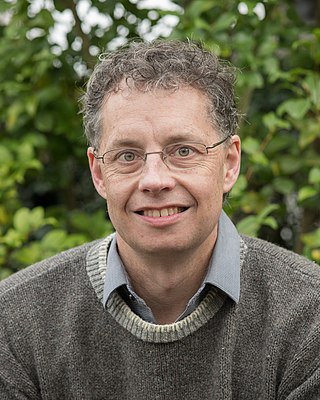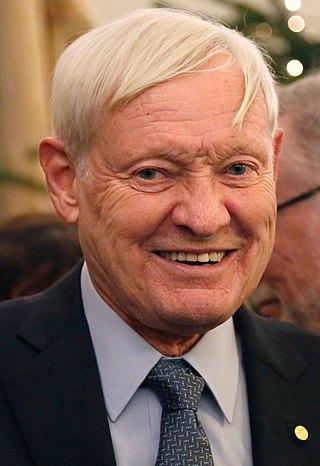Related Research Articles
Margaret Stratford Livingstone is the Takeda Professor of Neurobiology in the Department of Neurobiology at Harvard Medical School in the field of visual perception. She authored the book Vision and Art: The Biology of Seeing. She was elected a member of the American Academy of Arts and Sciences in 2015 and was elected to the National Academy of Sciences in 2020.

Rodolfo Llinás Riascos is a Colombian and American neuroscientist. He is currently the Thomas and Suzanne Murphy Professor of Neuroscience and Chairman Emeritus of the Department of Physiology & Neuroscience at the NYU School of Medicine. Llinás has published over 800 scientific articles.

James Edward Rothman is an American biochemist. He is the Fergus F. Wallace Professor of Biomedical Sciences at Yale University, the Chairman of the Department of Cell Biology at Yale School of Medicine, and the Director of the Nanobiology Institute at the Yale West Campus. Rothman also concurrently serves as adjunct professor of physiology and cellular biophysics at Columbia University and a research professor at the UCL Queen Square Institute of Neurology, University College London.

The Humboldt squid, also known as jumbo squid or jumbo flying squid (EN), and Pota in Peru or Jibia in Chile (ES), is a large, predatory squid living in the eastern Pacific Ocean. It is the only known species of the genus Dosidicus of the subfamily Ommastrephinae, family Ommastrephidae.

Bruce Michael Alberts is an American biochemist and the Emeritus Chancellor’s Leadership Chair in Biochemistry and Biophysics for Science and Education at the University of California, San Francisco. He has done important work studying the protein complexes which enable chromosome replication when living cells divide. He is known as an original author of the "canonical, influential, and best-selling scientific textbook" Molecular Biology of the Cell, as an Editor-in-Chief of Science magazine. He was awarded the National Medal of Science for "intellectual leadership and experimental innovation in the field of DNA replication, and for unparalleled dedication to improving science education and promoting science-based public policy" in 2014.

Gregory A. Petsko is an American biochemist and member of the National Academy of Sciences, the National Academy of Medicine, the American Academy of Arts and Sciences, and the American Philosophical Society. He is currently Professor of Neurology at the Ann Romney Center for Neurologic Diseases at Harvard Medical School and Brigham and Women's Hospital. He formerly had an endowed professorship in Neurology and Neuroscience at Weill Cornell Medical College and is still an adjunct professor of Biomedical Engineering at Cornell University, and is also the Gyula and Katica Tauber Professor, Emeritus, in biochemistry and chemistry at Brandeis University. On October 24, 2023, in a ceremony in the East Room of the White House, President Joe Biden presented Gregory Petsko and eight others with the National Medal of Science, the highest honor the United States can bestow on a scientist and engineer.
Axel T. Brunger is a German American biophysicist. He is Professor of Molecular and Cellular Physiology at Stanford University, and a Howard Hughes Medical Institute Investigator. He served as the Chair of the Department of Molecular and Cellular Physiology (2013–2017).
Pietro De Camilli NAS, AAA&S, NAM is an Italian-American biologist and John Klingenstein Professor of Neuroscience and Cell Biology at Yale University School of Medicine. He is also an Investigator at Howard Hughes Medical Institute. De Camilli completed his M.D. degree from the University of Milan in Italy in 1972. He then went to the United States and did his postdoctoral studies at Yale University with Paul Greengard.

Hans Joachim "John" Schellnhuber is a German atmospheric physicist, climatologist and founding director of the Potsdam Institute for Climate Impact Research (PIK) and former chair of the German Advisory Council on Global Change (WBGU). Since 1 December 2023, Schellnhuber is the Director General of IIASA.

Carl Theodore Bergstrom is a theoretical and evolutionary biologist and a professor at the University of Washington in Seattle, Washington, United States. Bergstrom is a critic of low-quality or misleading scientific research. He is the co-author of a book on misinformation called Calling Bullshit: The Art of Skepticism in a Data-Driven World and teaches a class by the same name at University of Washington.

Peter Guy Wolynes is an American theoretical chemist and physicist. Since 2011 he has been a Bullard-Welch Foundation Professor of Science and professor of chemistry at Rice University. He is widely recognized for his significant contributions to the theories of protein folding, glasses, and gene networks. Previously he was James R. Eiszner Professor at the University of Illinois at Urbana-Champaign, and the Francis H.C. Crick Chair of Physical Sciences at the University of California, San Diego.

Peter Hegemann is a Hertie Senior Research Chair for Neurosciences and a professor of Experimental Biophysics at the Department of Biology, Faculty of Life Sciences, Humboldt University of Berlin, Germany. He is known for his discovery of channelrhodopsin, a type of ion channels regulated by light, thereby serving as a light sensor. This created the field of optogenetics, a technique that controls the activities of specific neurons by applying light. He has received numerous accolades, including the Rumford Prize, the Shaw Prize in Life Science and Medicine, and the Albert Lasker Award for Basic Medical Research.
Rishikesh Narayanan is an Indian neuroscientist, computer engineer and a professor at the Molecular Biophysics Unit (MBU) of the Indian Institute of Science. He is the principal investigator at the Cellular Neurophysiology Laboratory of MBU where his team is engaged in researches on experimental and theoretical aspects of information processing in single neurons and their networks. The Council of Scientific and Industrial Research, the apex agency of the Government of India for scientific research, awarded him the Shanti Swarup Bhatnagar Prize for Science and Technology, one of the highest Indian science awards, in 2016, for his contributions to biological sciences.

Biman Bagchi is an Indian scientist currently serving as a SERB-DST National Science Chair Professor and Honorary Professor at the Solid State and Structural Chemistry Unit of the Indian Institute of Science. He is a theoretical physical chemist and biophysicist known for his research in the area of statistical mechanics; particularly in the study of phase transition and nucleation, solvation dynamics, mode-coupling theory of electrolyte transport, dynamics of biological macromolecules, protein folding, enzyme kinetics, supercooled liquids and protein hydration layer. He is an elected fellow of the Indian National Science Academy, the Indian Academy of Sciences, The World Academy of Sciences and an International honorary member of the American Academy of Arts and Sciences. Along with several scientific articles, he has authored three books, (i) Molecular Relaxation in Liquids, (ii) Water in Biological and Chemical Processes: From Structure and Dynamics to Function, and (iii) Statistical Mechanics for Chemistry and Materials Science.

Joachim Frank ; born September 12, 1940) is a German-American biophysicist at Columbia University and a Nobel laureate. He is regarded as the founder of single-particle cryo-electron microscopy (cryo-EM), for which he shared the Nobel Prize in Chemistry in 2017 with Jacques Dubochet and Richard Henderson. He also made significant contributions to structure and function of the ribosome from bacteria and eukaryotes.
Dr. Herbert Weissbach NAS NAI AAM is an American biochemist/molecular biologist.
Margaret McFall-Ngai is an American animal physiologist and biochemist best-known for her work related to the symbiotic relationship between Hawaiian bobtail squid, Euprymna scolopes and bioluminescent bacteria, Vibrio fischeri. Her research helped expand the microbiology field, primarily focused on pathogenicity and decomposition at the time, to include positive microbial associations. She currently is a professor at PBRC’s Kewalo Marine Laboratory and director of the Pacific Biosciences Research Program at the University of Hawaiʻi at Mānoa.
Brian M. Salzberg is an American neuroscientist, biophysicist and professor. He is Professor of Neuroscience and of Physiology at the Perelman School of Medicine, University of Pennsylvania.
Kuan Wang is a Taiwanese biochemist whose contributions to muscle biochemistry and cell biology have garnered more than 10,000 citations with an h-index of 54. After receiving a bachelor's degree in chemistry from Taiwan National University, he came to the United States for graduate study and earned a Ph.D. in molecular biophysics and biochemistry from Yale University under the guidance of Frederic M. Richards. He was an NIH Postdoctoral Fellow (1974–1976) at the University of California, San Diego, in the laboratory of S. J. Singer. In 1977 he joined the Department of Chemistry at the University of Texas at Austin as assistant professor. During his early years at UT, Wang and his co-workers discovered two previously unrecognized high molecular weight proteins of myofibrils, Titin and Nebulin, which fundamentally changed our understanding of muscle sarcomeres.
Gerd Ulrich "Uli" Nienhaus is a German physicist who is a professor and director of the Institute of Applied Physics, Karlsruhe Institute of Technology (KIT). At the KIT, he is also affiliated with the Institute of Nanotechnology, Institute of Biological and Chemical Systems, and Institute of Physical Chemistry, and he is an adjunct professor at the University of Illinois at Urbana-Champaign.
References
- ↑ Mossman, Kaspar (November 13, 2008). "Profile of Francisco Bezanilla". Proceedings of the National Academy of Sciences. 105 (46): 17597–17599. Bibcode:2008PNAS..10517597M. doi: 10.1073/pnas.0810116105 . ISSN 0027-8424. PMC 2584747 . PMID 19008354.
- 1 2 "Francisco Bezanilla". University of Chicago . Retrieved November 24, 2015.
- 1 2 3 Mossman, K. (November 13, 2008). "Profile of Francisco Bezanilla". Proceedings of the National Academy of Sciences. 105 (46): 17597–17599. Bibcode:2008PNAS..10517597M. doi: 10.1073/pnas.0810116105 . PMC 2584747 . PMID 19008354.
- ↑ Scully, Tony (August 20, 2008). "Neuroscience: The great squid hunt". Nature. 454 (7207): 934–936. doi: 10.1038/454934a . PMID 18719561.
- ↑ "Francisco Bezanilla". National Academy of Sciences . Retrieved November 24, 2015.
- ↑ "Past Officers". Biophysical Society . Retrieved November 24, 2015.
- ↑ Yonck, Richard (April 10, 2015). ""Optocapacitance" shines new light on the brain". Scientific American . Retrieved November 24, 2015.
- ↑ "Editorial Board | PNAS".
- ↑ Nealy, Michelle (February 2, 2012). "Emerging Scholars: Cell Biology Pioneer – Magdalena Bezanilla". Diverse: Issues in Higher Education. Retrieved November 24, 2015.